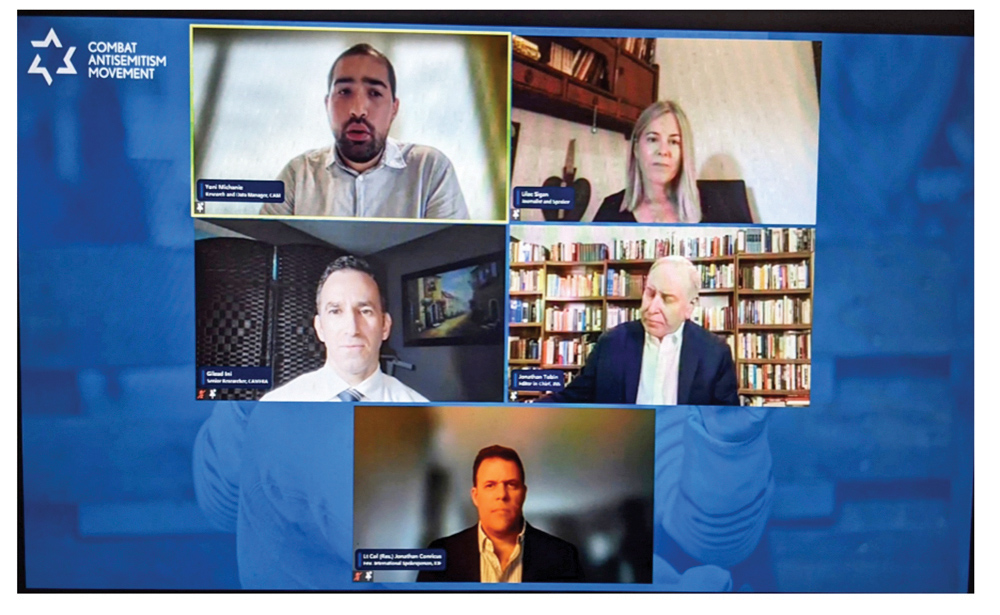
It’s long been an article of faith in the pro-Israel community that The New York Times is institutionally biased and consistently imbalanced in its coverage of Israel. A Zoom webinar on July 18 by the Combat Antisemitism Movement (CAM) offered solid research and a range of facts that lend credence to this conviction.
Featured on the Tuesday-morning broadcast were Jonathan Tobin, Gilead Ini, Jonathan Conricus and Lilac Sigan. The worldwide panel of activists fighting Jewish hatred was moderated by Yoni Michanie, research and data manager for CAM.
The lead speaker was Lilac Sigan, a writer and journalist whose work has appeared in The Jerusalem Post and Newsweek. In collaboration with International Communication and Public Diplomacy Professor Eytan Gilboa of Bar-Ilan University in Ramat Gan, she sought to document whether or not The New York Times reporting was actually biased against Israel. She read through every issue that came out in 2022. Her review showed that The New York Times consistently omits or minimizes critical details about the threats Israel faces. The research also indicated that the “Gray Lady” contains disproportionately negative content about the Jewish state and dramatically understates crimes committed by Palestinian terrorist groups against Jews and Israel.
Sigan found that the opinion page of the paper featured articles that were 65% negative to Israel, 23% positive and 12% neutral. References regarding Israel, including “apartheid,” “colonialism,” genocide,” “stealing,” “occupied” and “occupation” were often used. Items about Israel appeared in 1,628 stories in 2022. Sigan stated that The New York Times is not telling the whole story of what is going in. An example she gave was that there were 65 journalists killed in 2022. There were headlines about 16 of those killings and 24 headlines about the unfortunate incident with one Palestinian reporter.
The following speaker was Gilead Ini, senior researcher for CAMERA. He recapped the findings from his organization’s review of The New York Times in 2011. At that time, they concluded that criticism of Israel events was double that reported about Palestinians. His opinion was that it is worse today and extremism is on the rise. He said that news organizations are hiring “partisans” with an agenda, and that words in articles do not reflect reality; he called this “advocacy journalism.” One of his conclusions was that poisonous coverage of Israel leads to antisemitism and the growth of anti-Israel tropes.
Next up was retired Lieutenant Colonel Jonathan Conricus, a Givati Brigade alumna, who served for four years as the international spokesperson for Israeli Defense Forces. He stressed that in his experience The New York Times has intentionally provided anti-Israel coverage and often uses misleading visual journalism to illustrate its position. He said that the paper frequently confuses opinion with journalism.
The final guest was Jonathan Tobin, editor-in-chief of the Jewish News Syndicate. He said that it is not just the The New York Times that is negative, but there is bias throughout the media. Journalism today focuses on the underdog and, unlike 40 or 50 years ago, Israel is not considered an underdog. The media bias, and viewing Palestinians as victims, is rooted in academia. News reports often portray Israel as the villain.
Each guest had the opportunity to make closing remarks.
“We’re not doing enough, including Israel, to fight antisemitism,” said Sigan. “We also need to strengthen our bonds with all Jews.”
Ini said: “Newspapers have ‘preferred frames’ of what is covered and how it is covered. Newspapers decide what to print, and that ties into antisemitism.”
Conricus remarked: “Jew hatred is fed by this type of reporting. Israel needs to wake up and allocate resources to the international diaspora.” He agreed that we need to strengthen the bonds of Israel with Jewish people abroad.
“We need to do more and double our efforts,” Tobin asserted. “The New York Times doesn’t care what we think. We need to utilize other media; that’s our main focus. We need to reach people in other ways, and we need to reach out to all American Jewry and all Americans. We have to tilt against the windmill that is the The New York Times.”
For more information on CAM and their continuing research on antisemitism, see: https://combatantisemitism.org/research/
Milton Erdfarb, the son of two Holocaust survivors, lives with his wife, Deborah, in Highland Park. They are active members of Congregation Ahavas Achim.









